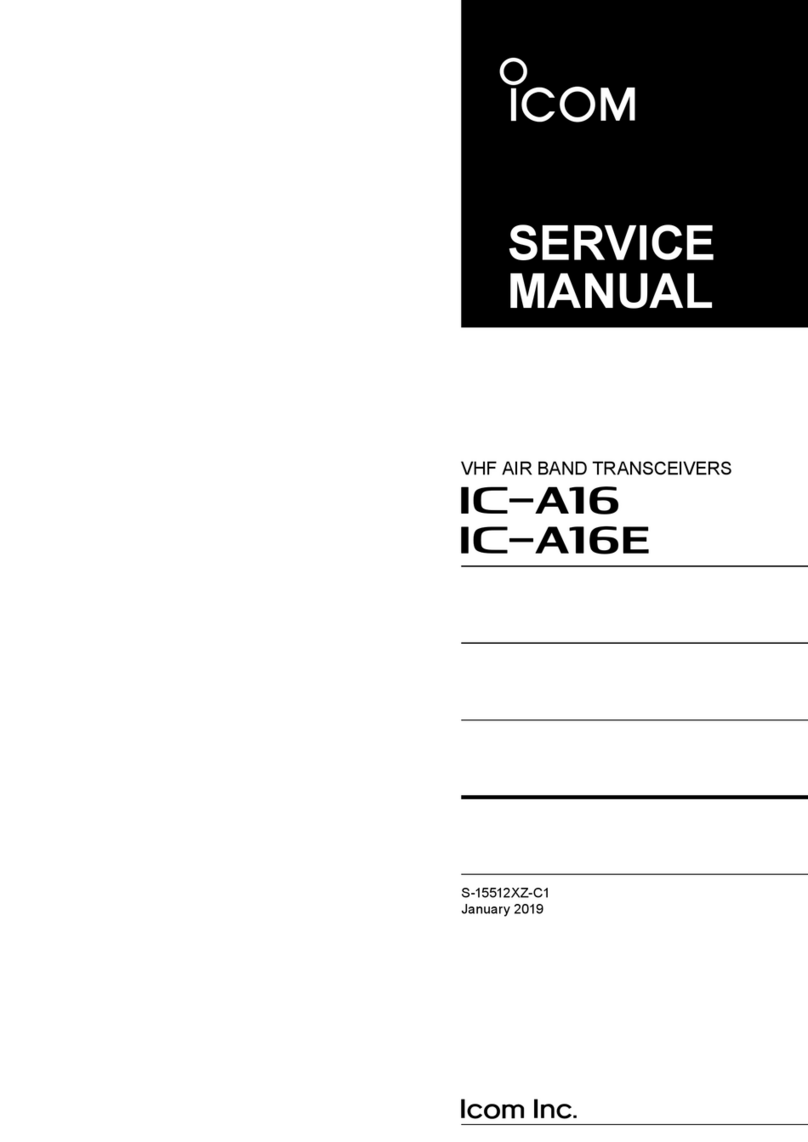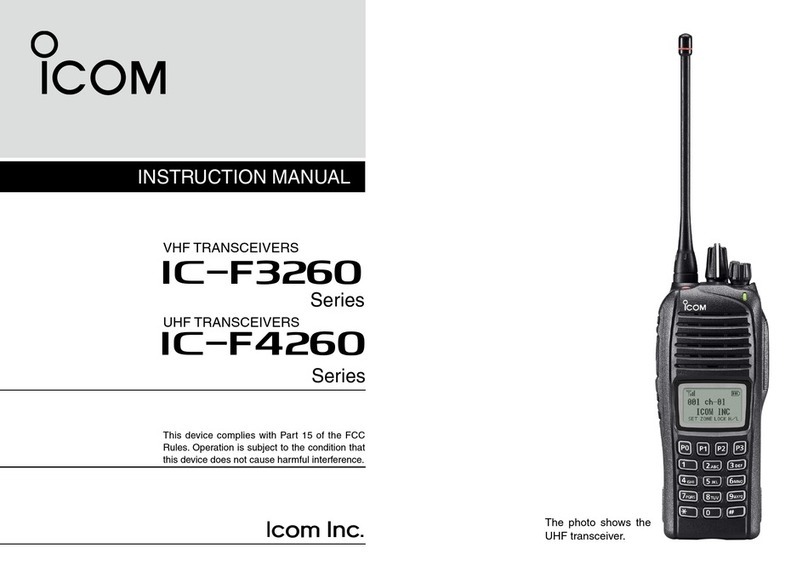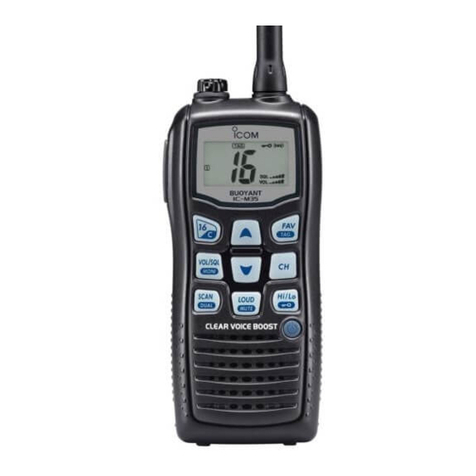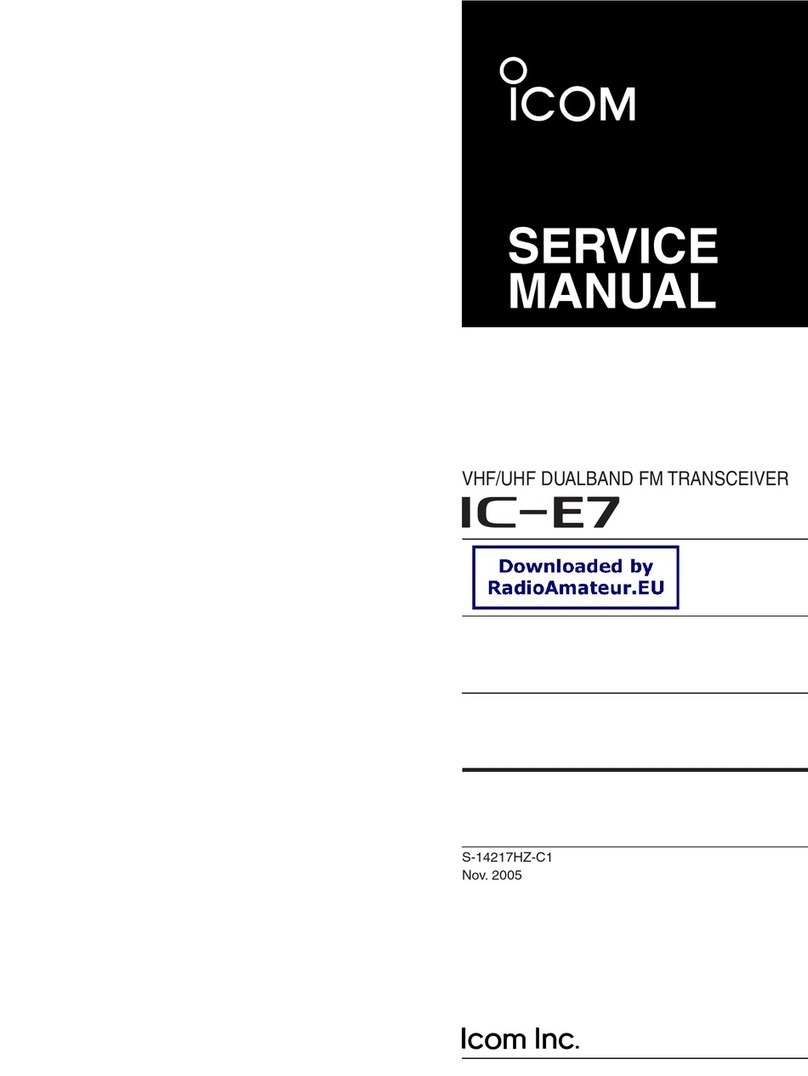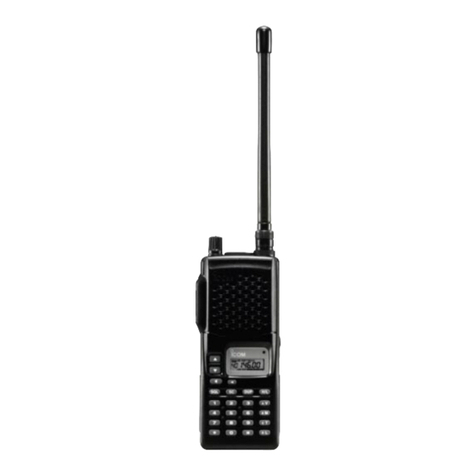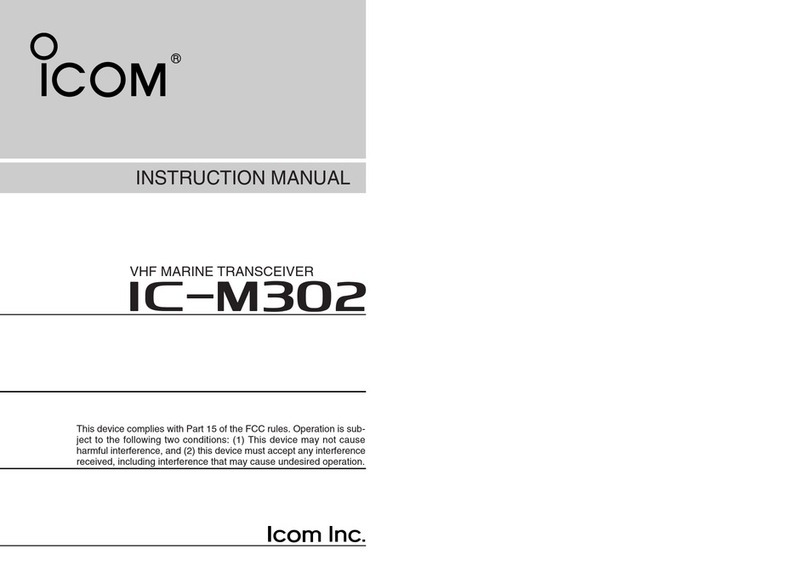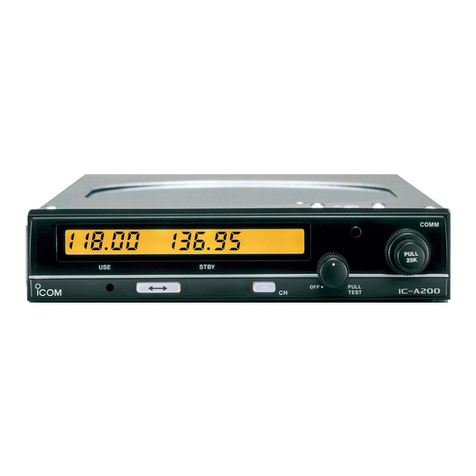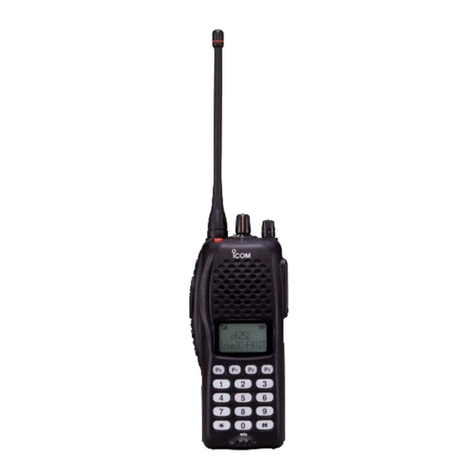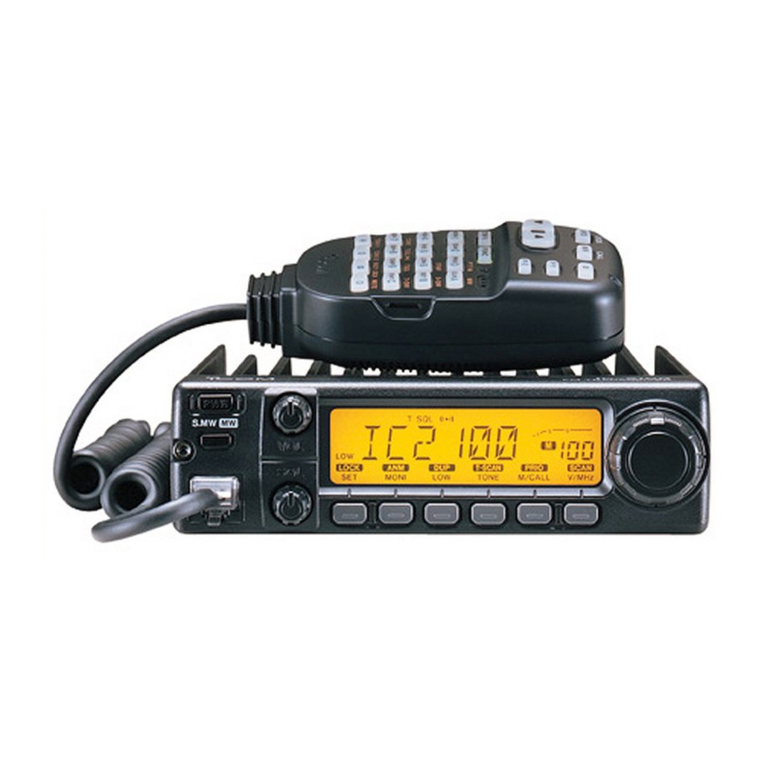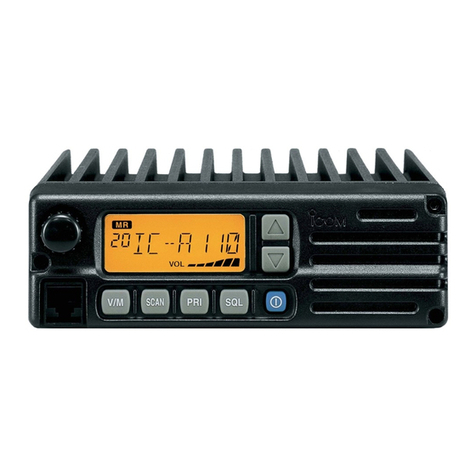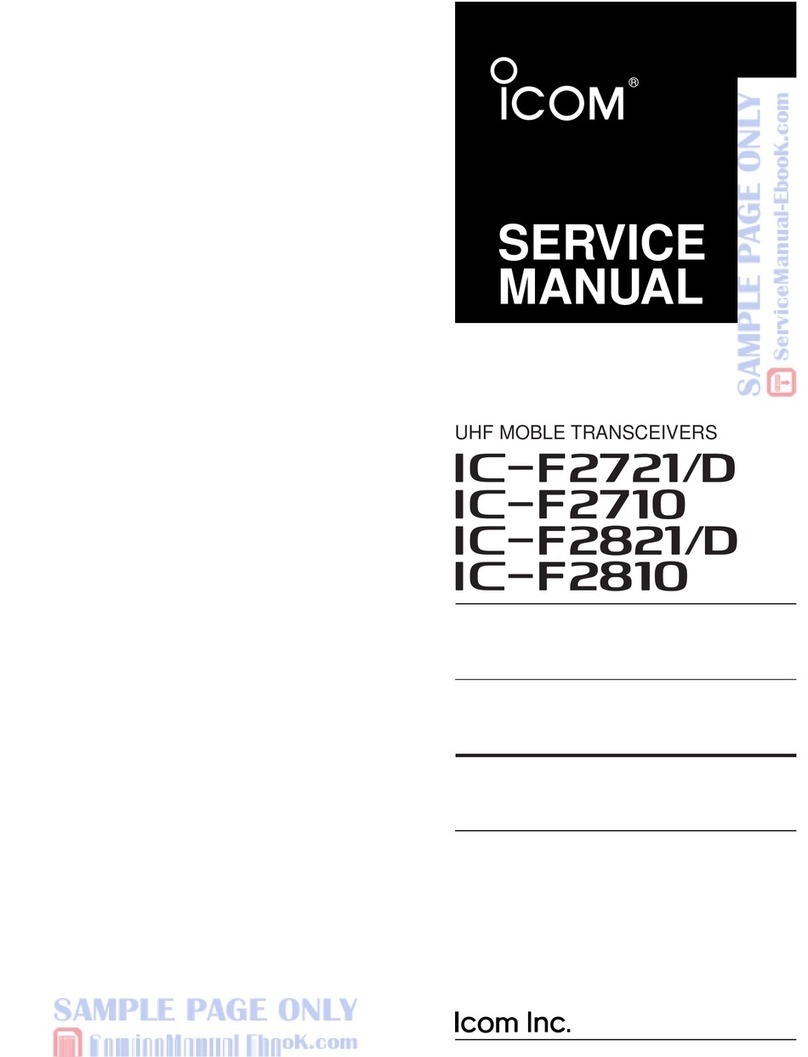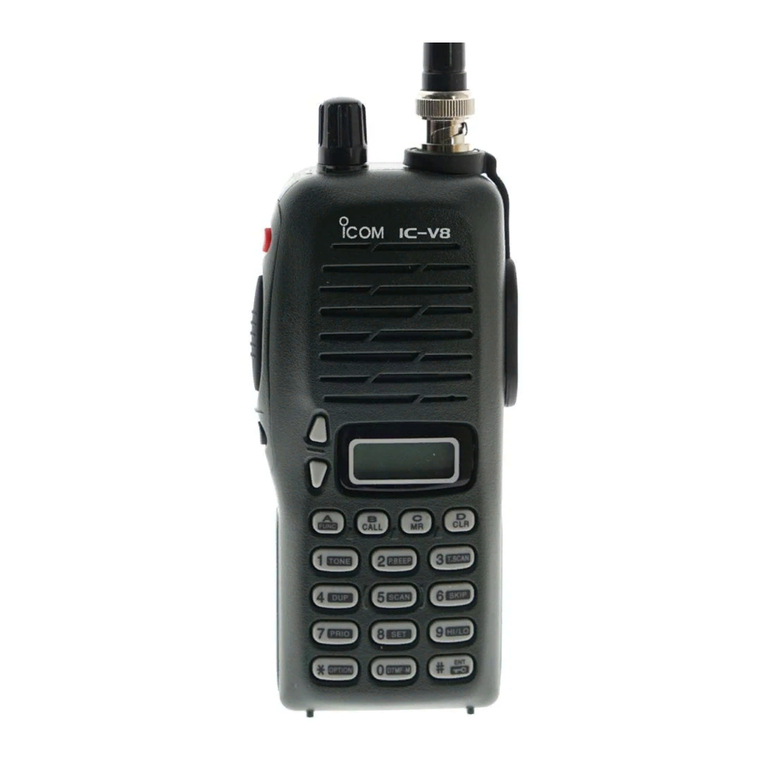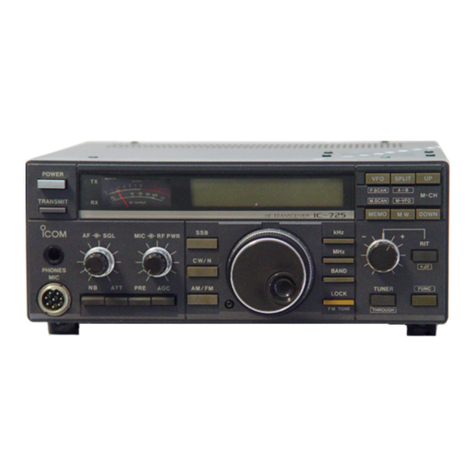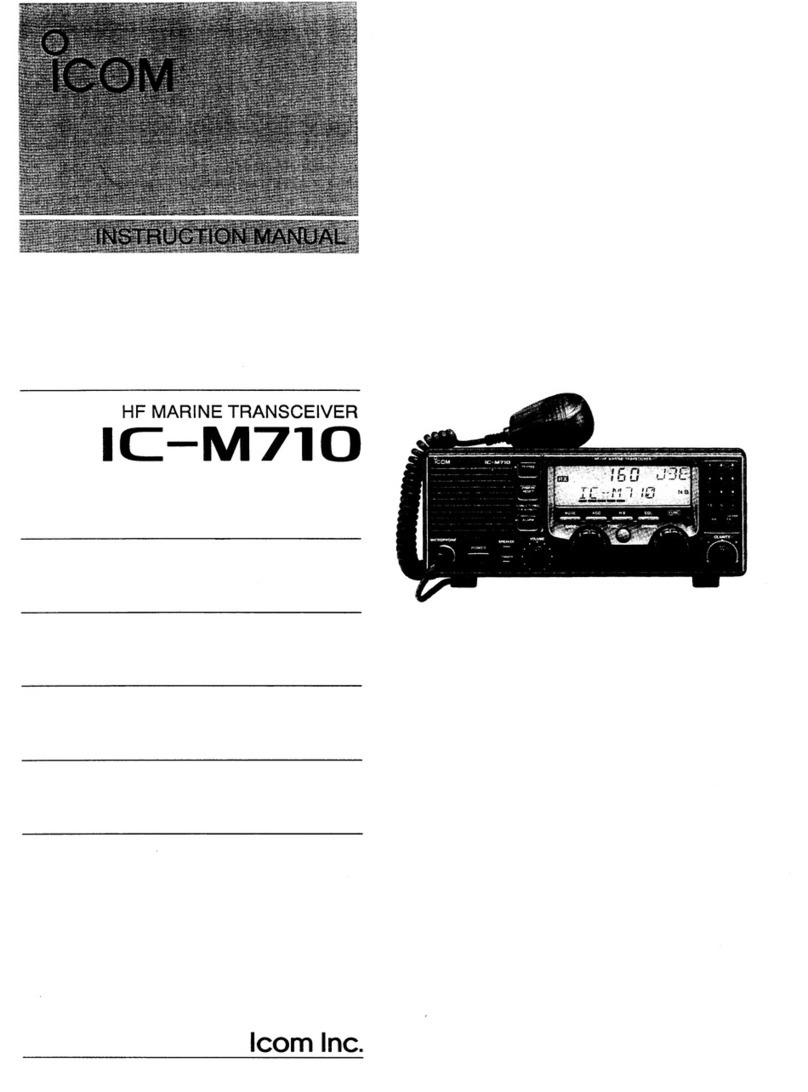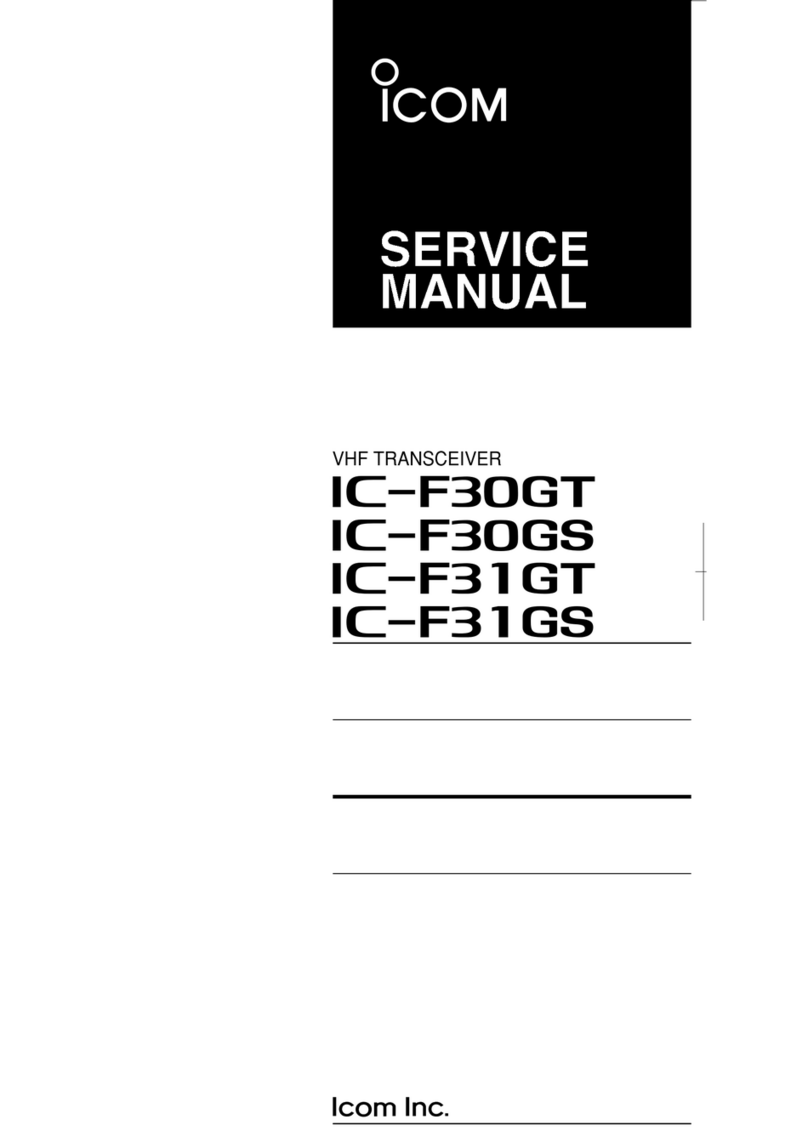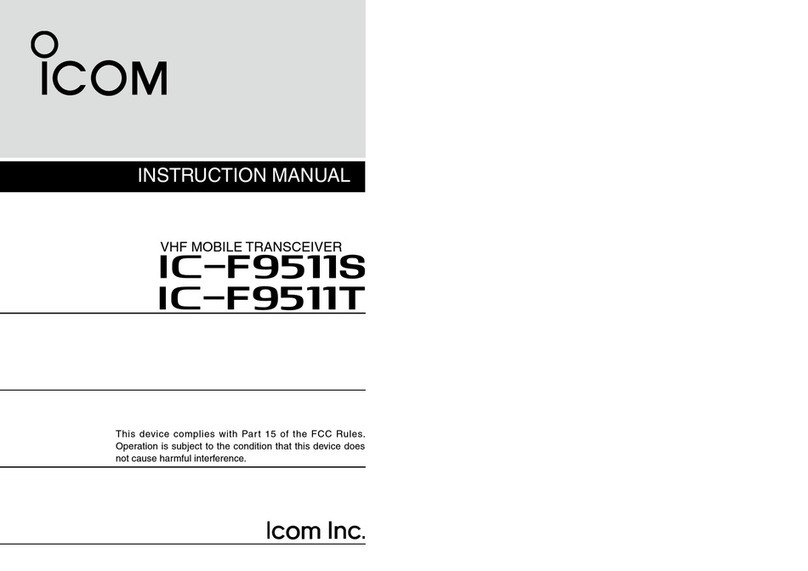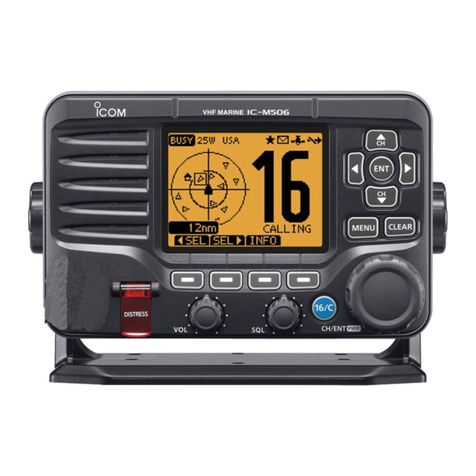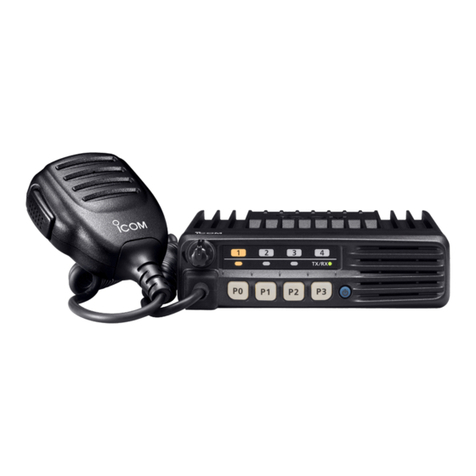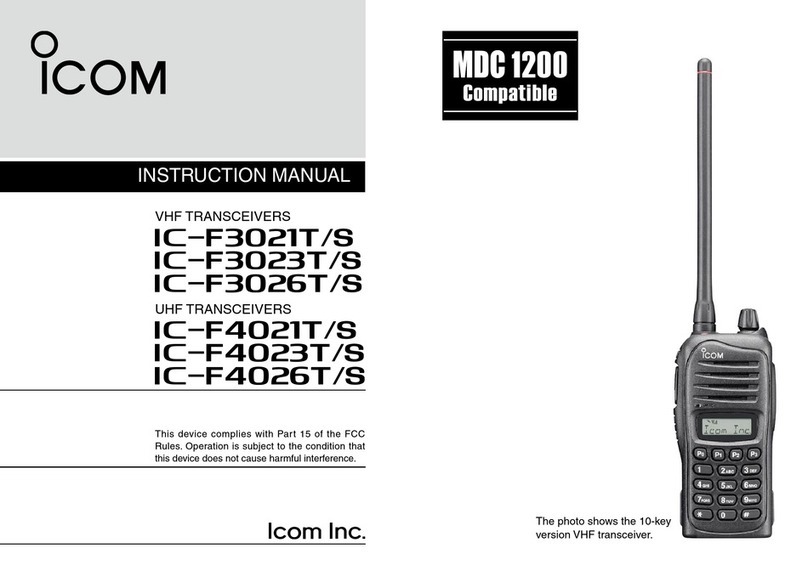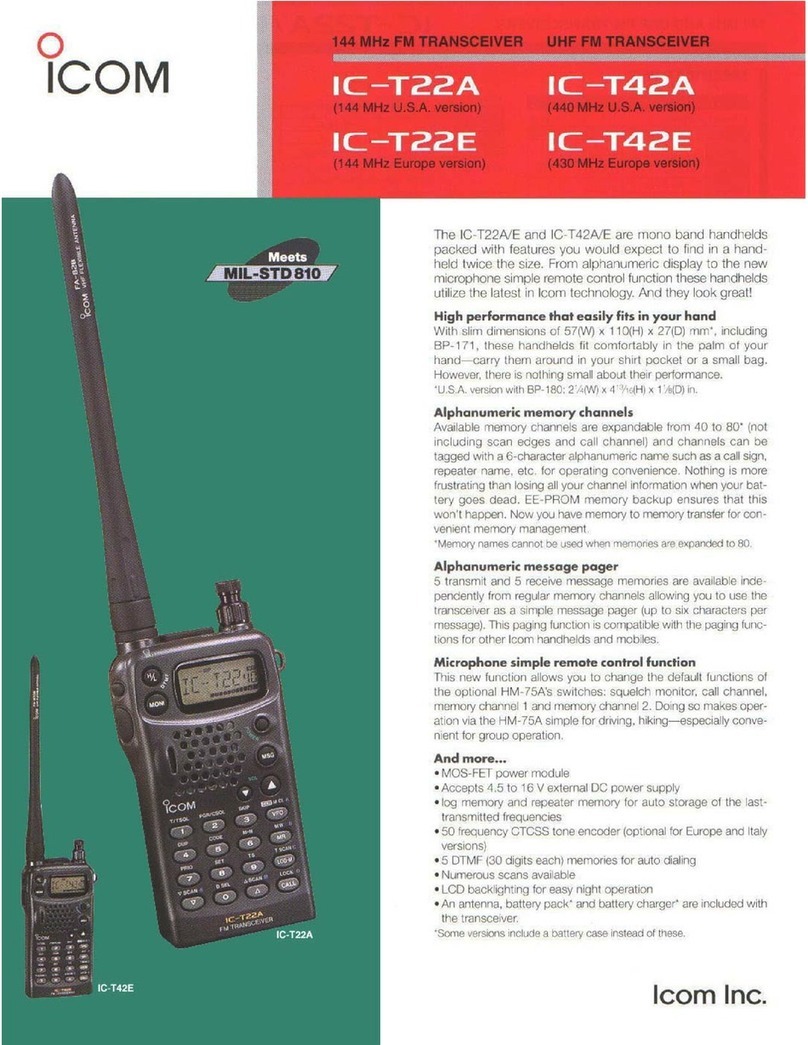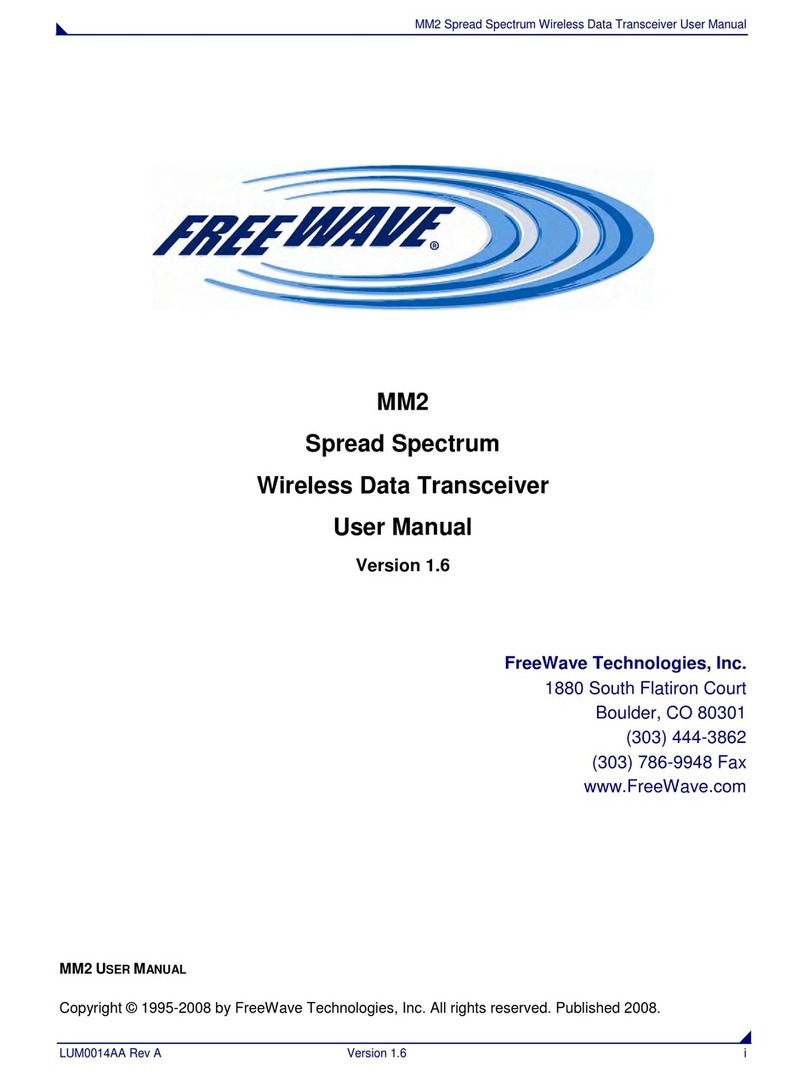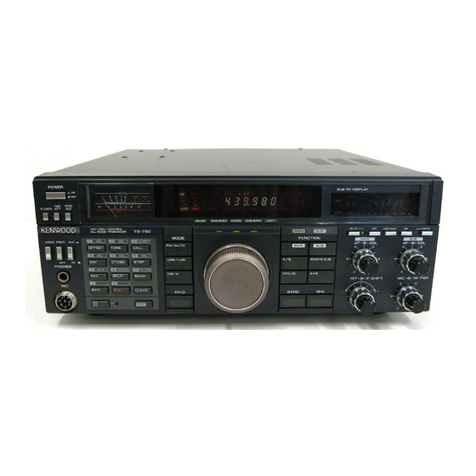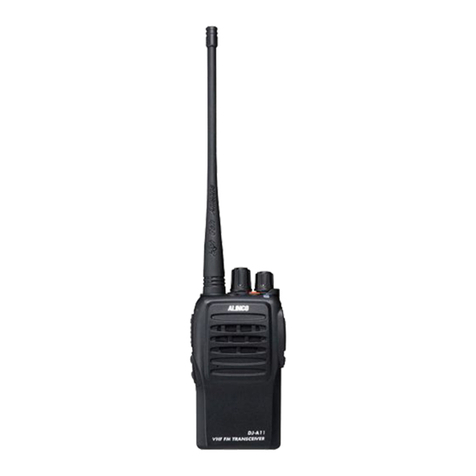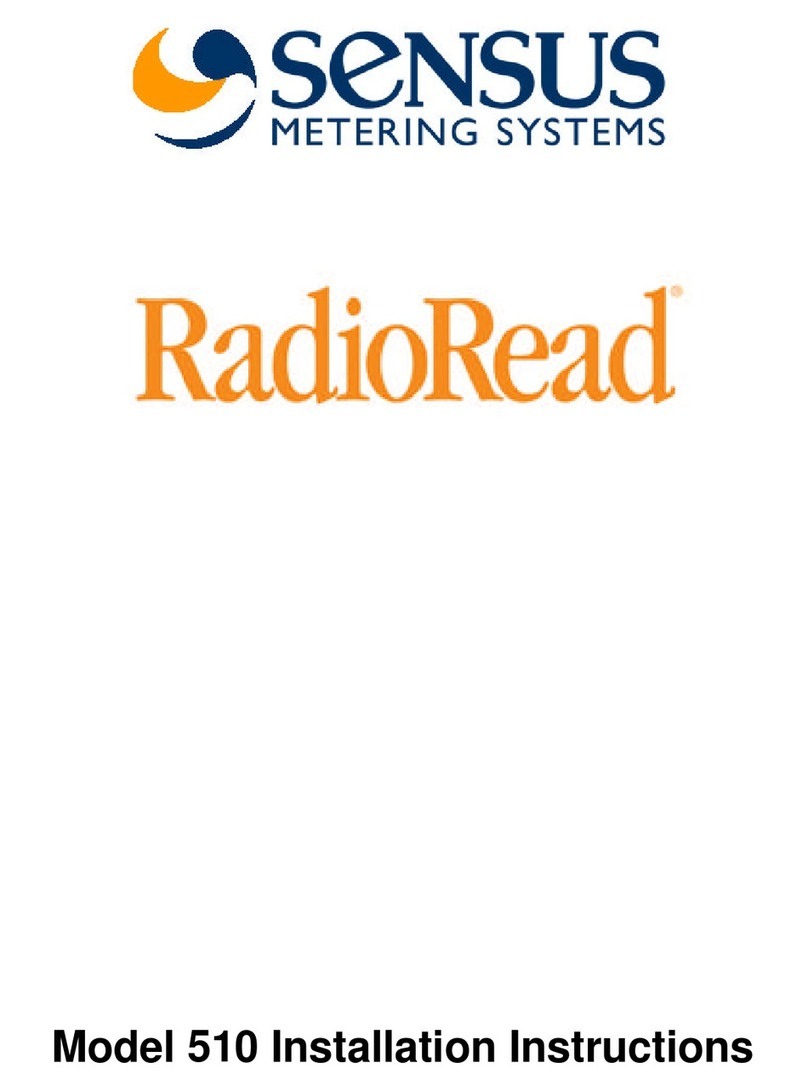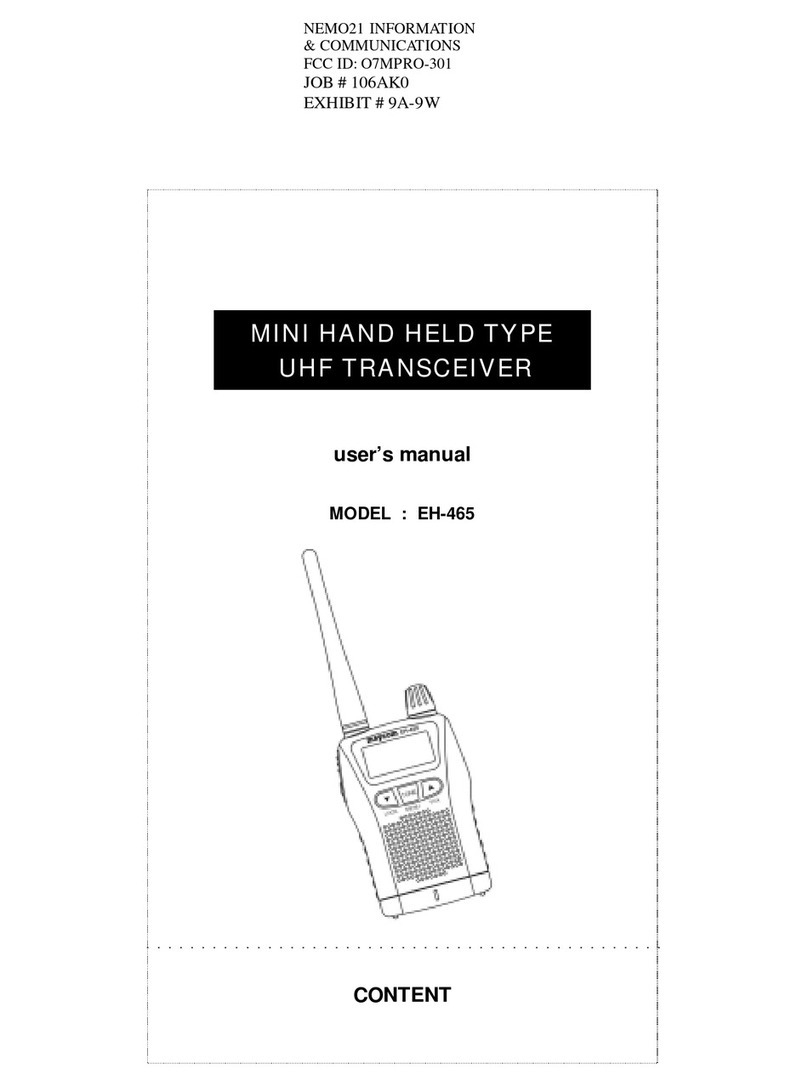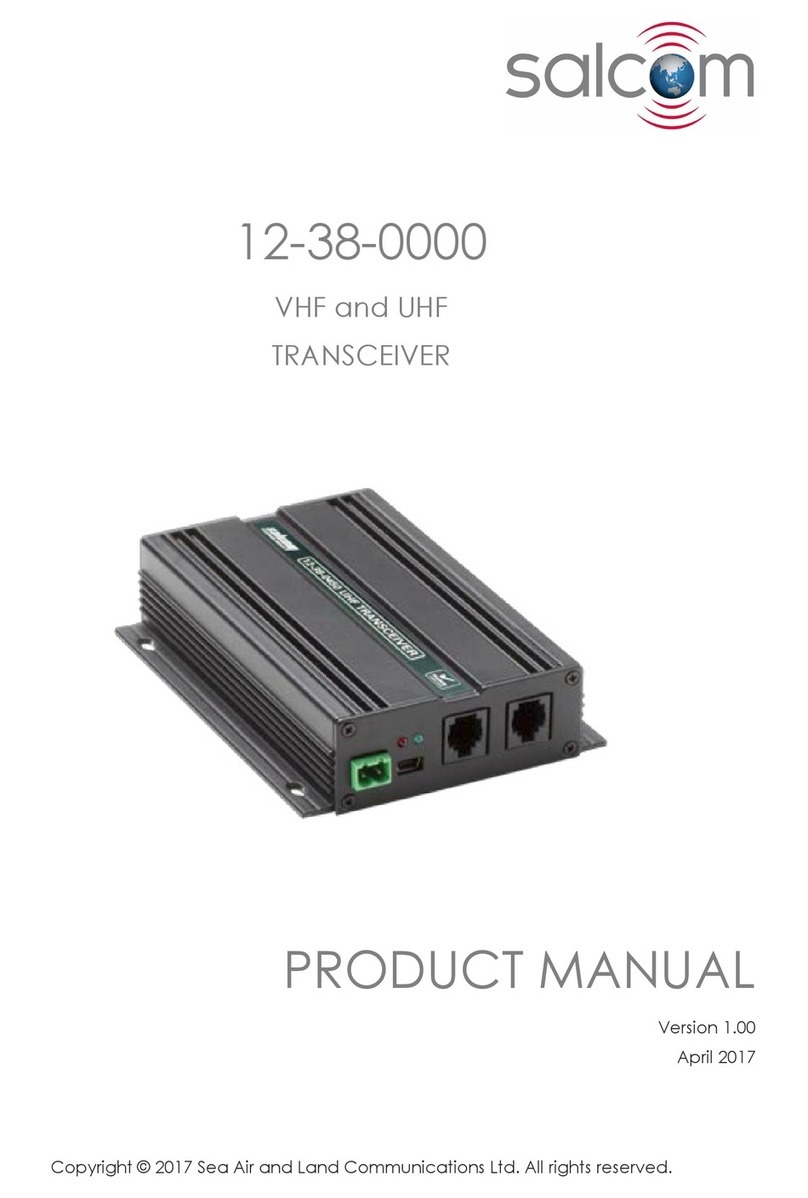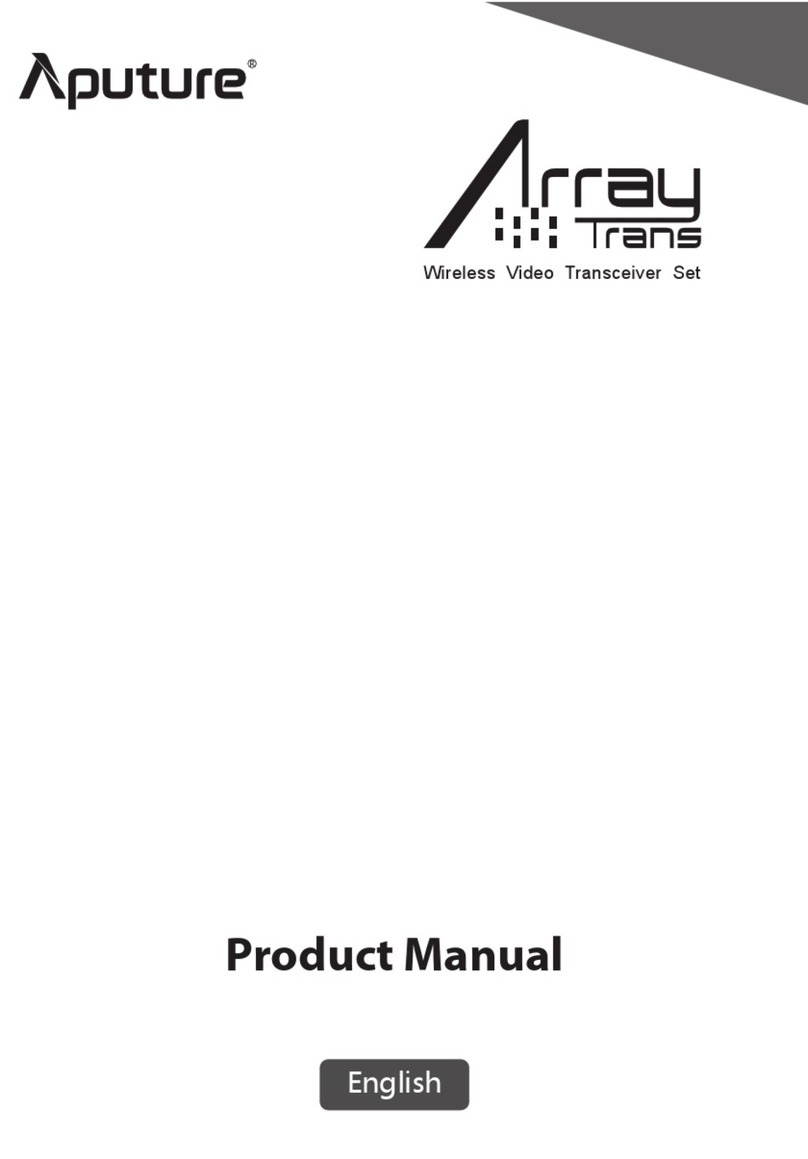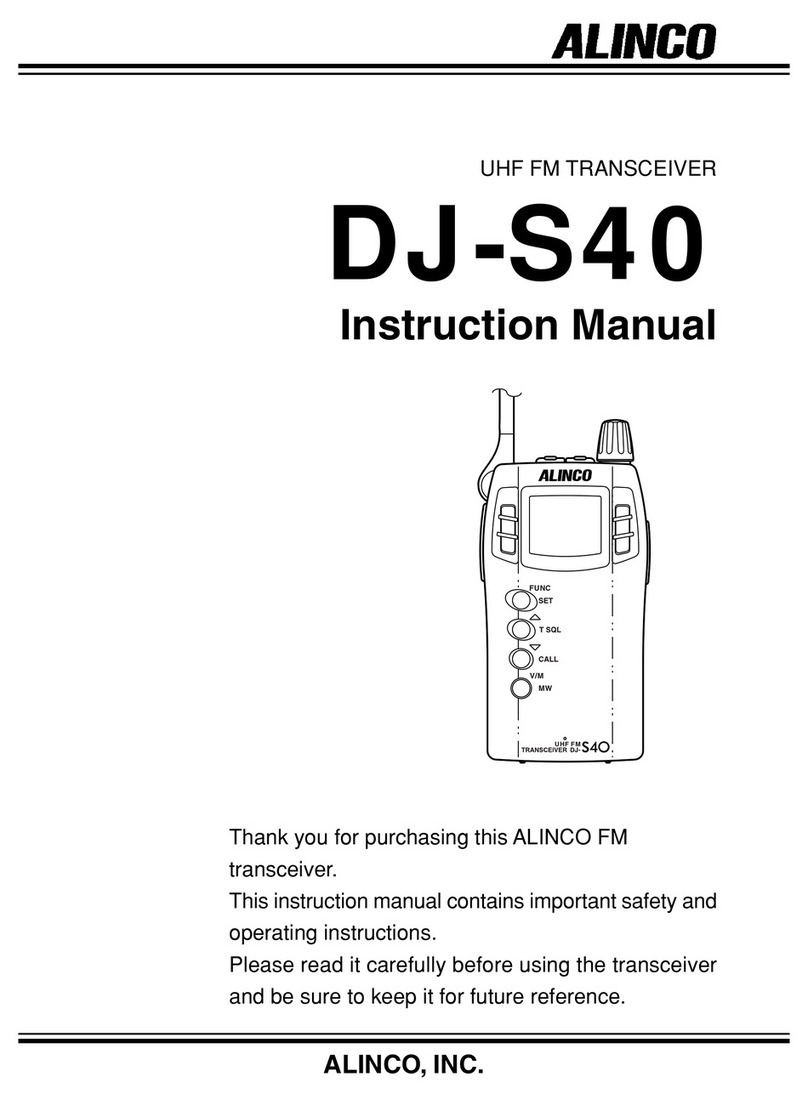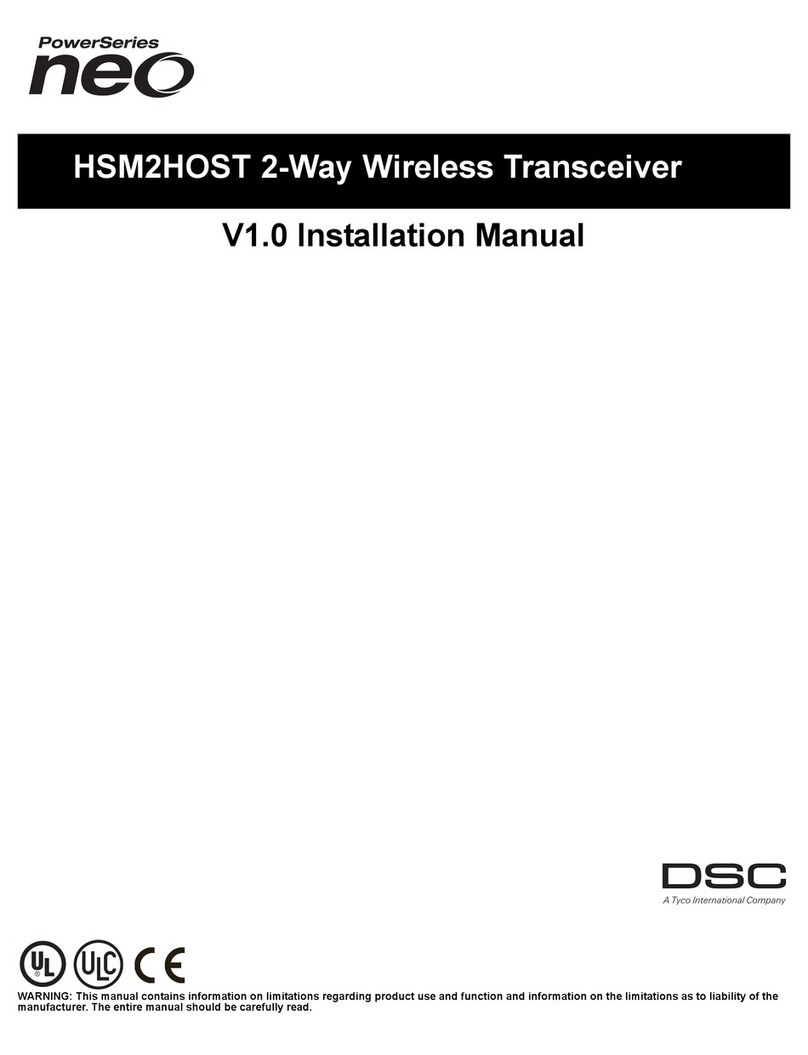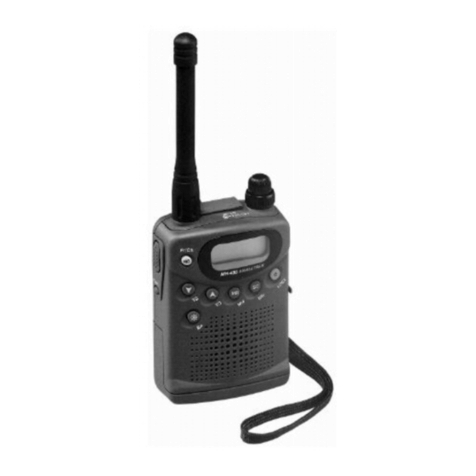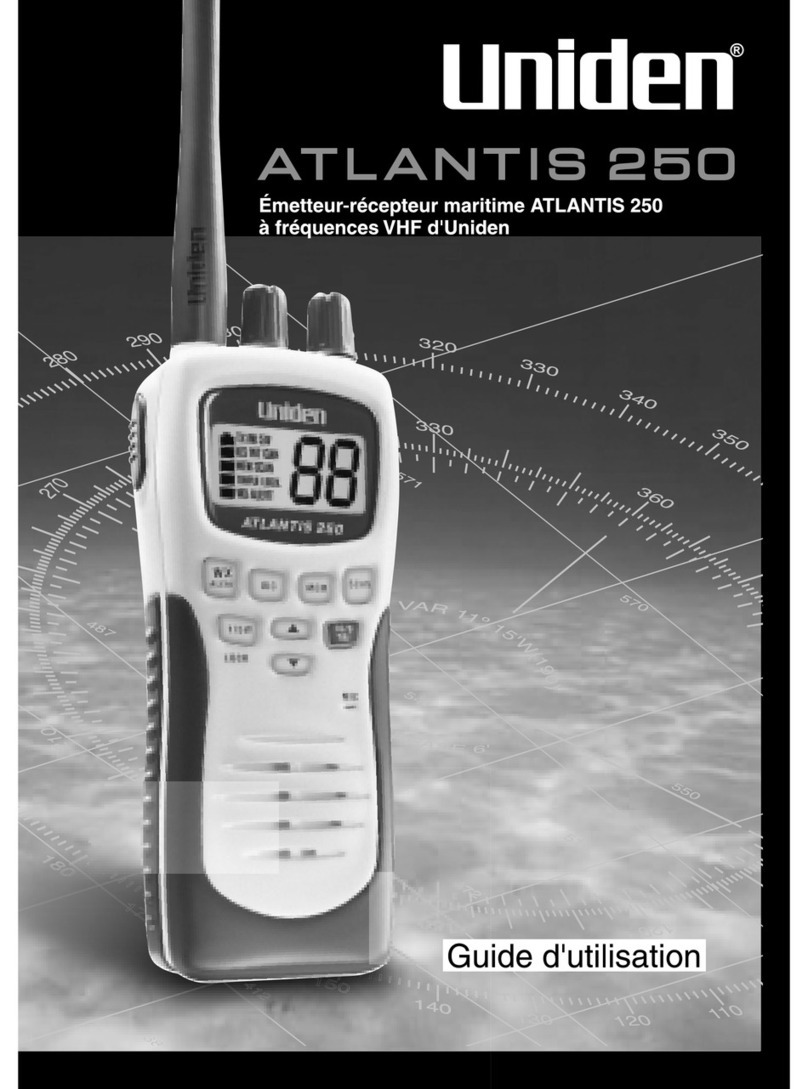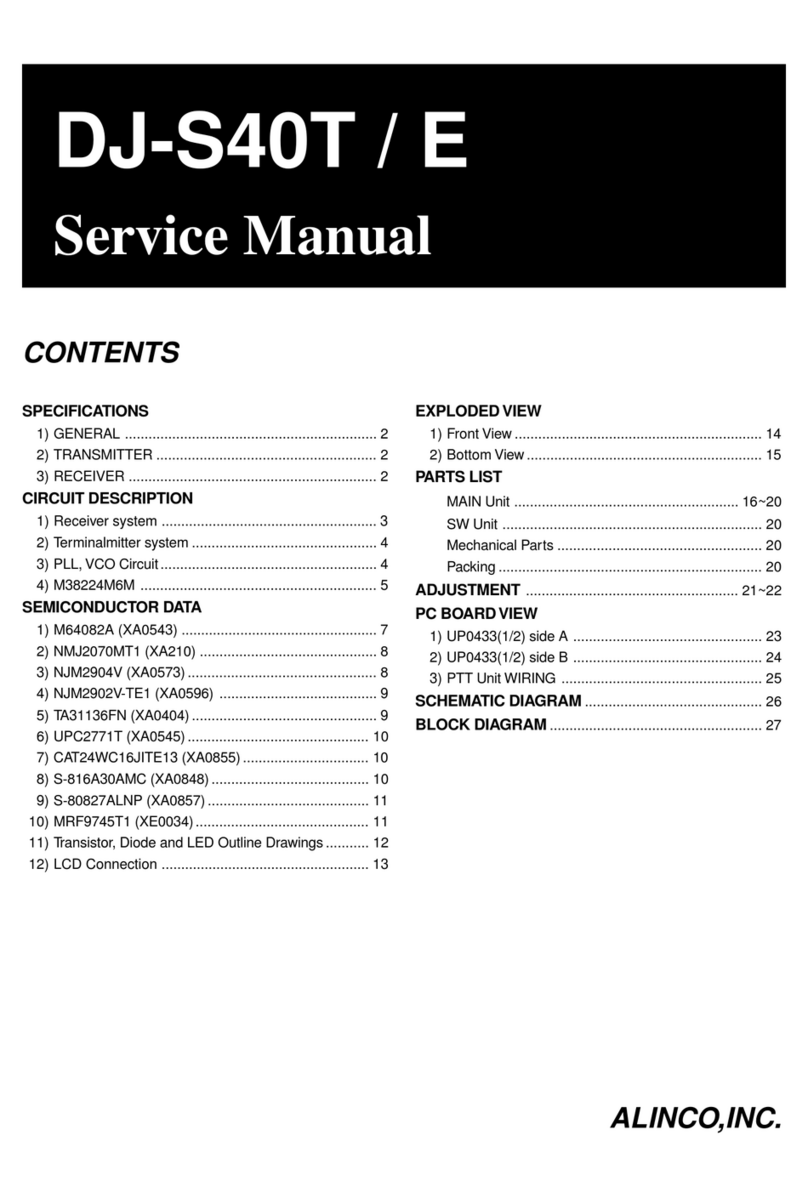Icom IC-A220T User manual

VHF AIR BAND TRANSCEIVER
INSTRUCTION MANUAL
• Certi ed TSO C128a and C169a
• This device complies with Part 15 of the FCC Rules. Operation is subject to
the condition that this device does not cause harmful interference.
iA220
A-7186D-1EX-4

i
IMPORTANT
READ ALL INSTRUCTIONS carefully and completely
before using the transceiver.
SAVE THIS INSTRUCTION MANUAL —This
instruction manual contains important operating instructions
for the IC-A220.
FCC INFORMATION
• FOR CLASS A UNINTENTIONAL RADIATORS:
This equipment has been tested and found to comply with
the limits for a Class A digital device, pursuant to part 15
of the FCC Rules. These limits are designed to provide
reasonable protection against harmful interference when the
equipment is operated in a commercial environment. This
equipment generates, uses, and can radiate radio frequency
energy and, if not installed and used in accordance with the
instruction manual, may cause harmful interference to radio
communications. Operation of this equipment in a residential
area is likely to cause harmful interference in which case the
user will be required to correct the interference at his own
expense.
CAUTION: Changes or modications to this transceiver, not
expressly approved by Icom Inc., could void your authority
to operate this transceiver under FCC regulations.
Thank you for choosing this Icom product.
This product is designed and built with Icom’ s state of
the art technology and craftsmanship. With proper care,
this product should provide you with years of trouble-free
operation.
EXPLICIT DEFINITIONS
The explicit denitions below apply to this instruction manual.
WORD DEFINITION
RWARNING! Personal injury, re hazard or electric shock
may occur.
CAUTION Equipment damage may occur.
NOTE
If disregarded, inconvenience only. No risk of
personal injury, re or electric shock.
• POUR LES RAYONNEMENTS NON INTENTIONNELS DE
CLASSE A:
Cet équipement a été testé et reconnu conforme aux
limites xées pour un appareil numérique de classe A,
conformément au point 15 de la réglementation FCC.
Ces limites sont dénies de façon à fournir une protection
raisonnable contre le brouillage préjudiciable lorsque cet
appareil est utilisé dans un environnement commercial. Cet
équipement génère, utilise et peut émettre un rayonnement
de fréquence radio. S'il n'a pas été installé conformément
aux instructions, il peut par ailleurs créer des interférences
perturbant les communications radio.
L'utilisation de cet appareil dans une zone résidentielle peut
provoquer un brouillage préjudiciable, auquel cas l'utilisateur
sera tenu de corriger la situation à ses frais.

DO NOT operate or place the transceiver in direct
sunlight or in areas with temperatures below –20°C (–4°F)
or above +55°C (+131°F).
DO NOT place the transceiver in excessively dusty
environments.
DO NOT use harsh solvents such as benzine or
alcohol to clean the transceiver, as they will damage the
transceiver’s surfaces. If the transceiver becomes dusty or
dirty, wipe it clean with a soft, dry cloth.
BE CAREFUL! The transceiver will become hot when
operating it continuously for long periods of time.
Icom, Icom Inc. and Icom logo are registered trademarks of Icom Incorporated
(Japan) in Japan, the United States, the United Kingdom, Germany, France,
Spain, Russia, Australia, New Zealand, and/or other countries.
ii
PRECAUTIONS
RWARNING! NEVER operate the transceiver with
a headset or other audio accessories at high volume levels.
The continuous high volume operation may cause a ringing
in your ears. If you experience the ringing, reduce the
volume level or discontinue use.
RWARNING! NEVER connect the transceiver to
an AC outlet or to a power source of more than 28 V DC.
Such a connection will damage the transceiver.
CAUTION: NEVER connect the transceiver to a
power source that is DC fused at more than 10 A. Accidental
reverse connection will be protected by this fuse, higher fuse
values will not give any protection against such accidents
and the transceiver will be damaged.
DO NOT operate the transceiver near unshielded electric
blasting caps or in an explosive atmosphere.
DO NOT connect the transceiver to a power source using
reverse polarity. This connection will not only blow fuses but
also may damage the transceiver.
DO NOT place unit in a non-secure place to avoid
inadvertent use by children.
DO NOT push the PTT when you do not actually intend
to transmit.
CAUTION: In Canada, use of 8.33 kHz Channel Spacing
of this radio is strictly prohibited and shall not be used.
Icom is not responsible for the destruction or damage to
the Icom transceiver, if the malfunction is because of:
• Force majeure, including, but not limited to, res,
earthquakes, storms, oods, lightning, other natural
disasters, disturbances, riots, war, or radioactive
contamination.
• The use of Icom transceivers with any equipment that is
not manufactured or approved by Icom.

iii
NE PAS placer l'émetteur-récepteur dans des endroits
excessivement poussiéreux.
NE PAS nettoyer l'appareil avec des solvants agressifs
tels que benzène ou alcool, susceptibles d'endommager les
surfaces exposées du boîtier. En cas de dépôt de poussière
ou de salissures sur l'émetteur-récepteur, il faut l'essuyer
avec chiffon doux et sec.
ATTENTION! Le transceiver devient chaud lors
d'utilisations continues de longue durée. L’émetteur-
récepteur chauffe en cas d’utilisation continue sur une
longue durée.
L'antenne doit être placée à au moins un mètre de la
position de chacune des personnes à bord de l'aéronef.
PRÉCAUTIONS
RNE JAMAIS utiliser l’émetteur-récepteur avec un
casque ou d’autres accessoires audio ayant un volume
trop élevé. Un volume continu trop fort peut entraîner
un bourdonnement dans vos oreilles. Si vous entendez
une sonnerie baissez le niveau sonore ou interrompez
l'utilisation.
RNE JAMAIS relier l'émetteurrécepteur à une
prise d'alimentation de plus de 28 V. Un tel branchement
endommagerait votre émetteur-récepteur.
NE JAMAIS brancher l’émetteur-récepteur à une
alimentation continue dont le fusible de protection excède
10 A. Ce fusible protège contre l’inversion accidentelle des
branchements.
NE PAS utiliser l'émetteur-récepteur près d'amorces
électriques non blindées ou en atmosphère explosive.
NE JAMAIS brancher le transceiver à une source
d'alimentation employant la polarité inversée.
NE PAS appuyer sur la touche PTT lorsqu’on ne souhaite
pas émettre.
NE PAS d’utiliser ou d’exposer l’émetteur-récepteur en
plein soleil ou à une tem pérature ambiante inférieure à
–20°C ou supérieure à +55°C.
MISE EN GARDE: Utilisation de 8,33 kHz Espacement
des canaux de cette radio est strictement interdite et ne
doit pas être utilisé au Canada.

iv
SAFETY TRAINING INFORMATION
Your Icom radio generates RF
electromagnetic energy during transmit
mode. This radio is designed for and
classied as “Occupational Use Only,”
meaning it must be used only during the
course of employment by individuals aware
of the hazards, and the ways to minimize
such hazards. This radio is NOT intended
for use by the “General Population” in an
uncontrolled environment.
• For compliance with FCC and Industry Canada RF
Exposure Requirements, the transmitter antenna
installation shall comply with the following two conditions:
1. The transmitter antenna gain shall not exceed 0 dBi.
2. The antenna is required to be located outside of a
vehicle and kept at a distance of 50 centimeters or
more between the transmitting antenna of this device
and any persons during operation. For a small vehicle,
the antenna as worst case, the antenna shall be
located on the roof top at any place on the centre line
along the vehicle in order to achieve 50 centimeters
separation distance. In order to ensure this distance is
met, the installation of the antenna must be mounted
at least 50 centimeters away from the nearest edge
of the vehicle in order to protect against exposure to
bystanders.
To ensure that your exposure to RF
electromagnetic energy is within the FCC
allowable limits for occupational use,
always adhere to the following guidelines:
• DO NOT operate the radio without a proper antenna
attached, as this may damage the radio and may also
cause you to exceed FCC RF exposure limits. A proper
antenna is the antenna supplied with this radio by the
manufacturer or an antenna specically authorized by the
manufacturer for use with this radio.
• DO NOT transmit for more than 50% of total radio use time
(“50% duty cycle”). Transmitting more than 50% of the time
can cause FCC RF exposure compliance requirements
to be exceeded. The radio is transmitting when the “TX”
indicator appears. You can cause the radio to transmit by
pressing the PTT switch.
Electromagnetic Interference/Compatibility
During transmissions, your Icom radio generates RF energy
that can possibly cause interference with other devices or
systems. To avoid such interference, turn off the radio in
areas where signs are posted to do so. DO NOT operate
the transmitter in areas that are sensitive to electromagnetic
radiation such as hospitals, and blasting sites.

v
INFORMATION EN MATIÈRE DE SÉCURITÉ
Votre radio Icom produit une énergie
électromagnétique de radiofréquences (RF), en
mode de transmission. Cette radio est conçue
pour un «usage professionnel seulement» et
classée comme tel, ce qui signie qu'elle doit
être utilisée uniquement dans le cadre d'un
travail par des personnes conscientes des
dangers et des mesures visant à minimiser
ces dangers. Elle N'EST PAS conçue pour
une «utilisation grand public», dans un
environnement non contrôlé.
• An de satisfaire aux exigences de la FCC et d'Industrie Canada
en matière d'exposition aux RF, il est nécessaire que l'antenne soit
installée conformément aux deux conditions suivantes:
1.
Le gain de l'antenne du radio émetteur ne doit pas dépasser 0 dBi.
2. Il faut que l'antenne émettrice de cet appareil soit placée
à l'extérieur d'un véhicule et tenue éloignée d'au moins 50
centimètres de toute personne pendant le fonctionnement.
Dans le pire des cas, pour un petit véhicule, l'antenne doit
être placée sur le toit, n'importe où dans l'axe central du
véhicule, an de respecter une distance de 50 cm du bord le
plus rapproché du véhicule et ainsi éviter que les personnes
présentes soient exposées.
An de vous assurer que votre exposition à une
énergie électromagnétique de RF se situe dans les
limites permises par la FCC pour une utilisation
grand public, veuillez en tout temps respecter les
directives suivantes:
•
NE PAS faire fonctionner la radio sans qu'une antenne appropriée
y soit xée, car ceci risque d'endommager la radio et causer une
exposition supérieure aux limites établies par la FCC. L'antenne
appropriée est celle qui est fournie avec cette radio par le fabricant
ou une antenne spécialement autorisée par le fabricant pour être
utilisée avec cette radio.
• NE PAS émettre pendant plus de 50% du temps total d'utilisation
de l'appareil («50% du facteur d'utilisation»). Émettre pendant plus
de 50% du temps total d'utilisation peut causer une exposition
aux RF supérieure aux limites établies par la FCC. La radio est
en train d’émettre lorsque le témoin du mode de transmission
s'afche sur l'écran ACL. La radio émettra si vous appuyez sur le
bouton du microphone.
Interférence électromagnétique et compatibilité
En mode de transmission, votre radio Icom produit de l'énergie de
RF qui peut provoquer des interférences avec d'autres appareils ou
systèmes. Pour éviter de telles interférences, mettez la radio hors
tension dans les secteurs où une signalisation l’exige. NE PAS faire
fonctionner l'émetteur dans des secteurs sensibles au rayonnement
électromagnétique tels que les hôpitaux et les sites de dynamitage.
AVERTISSEMENT
MISE EN GARDE

vi
TABLE OF CONTENTS
IMPORTANT .......................................................................... i
FCC INFORMATION ............................................................. i
EXPLICIT DEFINITIONS ....................................................... i
PRECAUTIONS .................................................................... ii
SAFETY TRAINING INFORMATION ................................... iv
INFORMATION EN MATIÈRE DE SÉCURITÉ ..................... v
1 PANEL DESCRIPTION................................................1–3
■Front panel ...................................................................1
■Rear panel ...................................................................2
■Function display ...........................................................3
2 BASIC OPERATION....................................................4–6
■General description ......................................................4
■Receiving and transmitting ...........................................5
■ Directly setting the frequency .......................................6
■Squelch settings ...........................................................6
3 MEMORY OPERATION.............................................7–12
■General description ......................................................7
■Basic operation ............................................................8
■ Editing Regular memory/Group memory channels ......8
■ Selecting a
weather memory channel .........................12
■History memory channel ............................................12
■Protecting memory .....................................................12
4 OTHER FUNCTIONS ..............................................13–16
■Dualwatch operation ..................................................13
■Priority watch .............................................................13
■ Accessing the 121.5 MHz emergency frequency .......14
■Enabling the intercom ................................................14
■Opening the squelch for test ......................................14
■Setting the frequency step .........................................15
■Using the remote control ............................................15
■ Scanning the weather memory channels ...................15
■Low voltage indicator .................................................16
5 MENU MODE...........................................................17–24
■Using the menu mode ................................................17
■Settings menu items ..................................................19
■Conguration menu items ..........................................21
6 SPECIFICATIONS .........................................................25
7 INFORMATION..............................................................26
■TSO Deviation list ......................................................26
■VFO channel ID list ....................................................26
8 ABOUT CE ..............................................................27–28
■DOC ...........................................................................27
■Disposal .....................................................................28
INDEX.................................................................................29

1
1PANEL DESCRIPTION
qDUAL KEY [DUAL]
➥ Push to turn Dualwatch operation ON or OFF. (p. 13)
➥ Hold down for two seconds to turn the intercom
function ON or OFF.
wEMERGENCY CHANNEL KEY [EC]
➥ Push to set the emergency frequency (121.5 MHz) as
the standby frequency. (p. 14)
➥ Hold down for two seconds to enter the direct
frequency setting mode (p. 6), and set the emergency
frequency (121.5 MHz). (p. 14)
eVOLUME/POWER SWITCH [VOL]
➥ Turn ON or OFF the transceiver.
➥ Adjusts the audio output level.
The volume level bar is displayed while rotating [VOL].
➥ Hold down for two seconds to enter the AM squelch
level “SQL LEVEL” item in the Settings menu. (p. 6)
➥ Push to turn ON or OFF the squelch test function.
(p. 14)*
* When the squelch test function is ON, and the Auto squelch
“AUTO SQL” item in the Conguration menu (p. 21) is set
to “USER SET,” push [VOL] again to change the squelch
mode. (p. 6)
RCL
MEM
OFF
VOL
PUSH
TEST
COMM
DUAL
EC
CH09 SAMPLE
121.525
118.00
RX MEMORY
eytriouqw
■Front panel
CAUTION: DO NOT turn ON power until the
engines have been started. Otherwise, the power
supply circuit may damage.

r FREQUENCY EXCHANGE (FLIP-FLOP) KEY [ ]
➥ Push to exchange the standby frequency with the
active frequency. (p. 5)
➥ Hold down for two seconds to enter the direct
frequency setting mode. (p. 6)
t MEMORY KEY [MEM]
Hold down for 2 seconds to enter the displayed frequency
into any blank regular memory channel or clear or
revive the selected memory channel (depending on the
operating mode).
yRECALL KEY [RCL]
➥ Push to enter or exit the memory mode. (p. 8)
➥ Hold down for two seconds to enter the Settings
menu. (p. 17)
➥ Push to exit the Settings menu. (p. 17)
u LIGHT-SENSITIVE DETECTOR
This detector senses ambient light. The detector is used
to automatically adjust “DISP LOW” or “DISP HIGH”
(pp. 22, 23) when the “DISP MODE” (p. 22) is set to
‘AUTO.’
i INNER (Small) TUNING DIAL [DIAL]
➥ Rotate to set the standby frequency (kHz digit)
(p. 5), or select a memory channel (p. 8), or menu
mode setting.
(pp. 17, 18)
o OUTER (Large) TUNING DIAL [O-DIAL]
Rotate to set the standby frequency (MHz digit) (p. 5),
select a group memory channel (p. 8), select the input
digit for group name (p. 10), and so on.
■Rear panel
2
1
PANEL DESCRIPTION
01
qw
e q
e
For regular type
Optional MBA-3
q
w
e
qANTENNA CONNECTOR
Connect the antenna connector.
wD-SUB 25 PIN CONNECTOR
Connect a 13.8 V or 27.5 V DC power supply, speaker,
and headset.
Refer to ‘INSTALLATION GUIDE’ for details.
NOTE: If any external intercom system is in use, we
recommend that you disable the transceiver’s intercom
function to prevent degradation of the audio signal. If any
degradation exists, leave pin 17 disconnected and disable
the transceiver’s intercom function (p. 23).

3
1PANEL DESCRIPTION
3
■Function display
CH09 SAMPLE
TEST
121.525
118.00
RX DUAL MEMORY RX
ICSTX
AU
LVD
etr y e
io!
2
uq
!
1
w
!
0
qACTIVE FREQUENCY READOUT
➥ Displays the active frequency. (p. 5)
➥ Displays the menu mode items in the menu mode.
(p. 17)
wTX INDICATOR
Displayed while transmitting. (p. 5)
eRX INDICATOR
➥ Displayed when receiving a signal on the active
frequency. (p. 5)
➥ Displayed when receiving a signal on the standby
frequency during Dualwatch operation. (p. 13)
➥ Displayed when opening the active frequency’s
squelch function. (p. 5)
rINTERCOM READOUT
Displays “ICS” when the intercom function is in use.
(p. 14)
tDUALWATCH READOUT
Displays “DUAL” when the Dualwatch function is ON.
(p. 13)
yMEMORY TYPE READOUT
➥ Displays “MEMORY” when the regular memory
channel is selected. (p. 8)
➥ Displays “GRP01”–“GRP05” when the group
memory channel is selected. (p. 8)
The group name is also displayed if the name has
been entered.
➥ Displays “HISTORY” when the history memory
channel is selected. (p. 12)
➥ Displays “WEATHER” when the weather memory
channel is selected. (p. 12)
uSTANDBY FREQUENCY READOUT
➥ Displays the standby frequency. (p. 5)
➥ Displays options in the menu mode. (p. 17)
iCHANNEL NAME READOUT
Displays the channel name in the memory mode. (p. 10)
oMEMORY CHANNEL READOUT
Displays the selected memory channel number in the
memory mode. (p. 8)
!0 LOW VOLTAGE INDICATOR
Displays “LVD” when the voltage is low. (p. 16)
!1 SQUELCH MODE READOUT
Displays the squelch mode status. (pp. 6, 19)
!2 TEST INDICATOR
Displays “
TEST
” while the squelch test function is ON.
(p. 14)

■General description
The ow chart below shows the basic operating procedures.
You need to set the frequency, activate the frequency, and
receive or transmit.
There are two ways to set the frequency. See page 5 and 6
for details.
• Set the frequency normally • Set the frequency directly
Set the frequency normally
Set the frequency which will be used for the next operating
frequency in the standby frequency display. Then exchange
the active frequency for the standby frequency.
Set the frequency directly
You can directly set the frequency.
See ‘Directly setting the frequency.‘
4
2
BASIC OPERATION
01
02
TIP: For quick frequency setting, you can enter often-
used frequencies into memory channels. See “MEMORY
OPERATION” for details. (pp. 7–12)
When you recall a memory channel, the previous standby
frequency is over written.
Set the standby frequency.
Activate the frequency.
Enter the direct frequency
setting mode.
Set the operating frequency.
Receive/transmit

5
2BASIC OPERATION
■Receiving and transmitting
1. Setting the standby frequency
Rotate [DIAL] and [O-DIAL] to set the standby frequency.
• The active frequency is not affected.
• Rotate [O-DIAL] to set above 1 MHz digit.
• Rotate [DIAL] to set below 100 kHz digit.
• You can set the frequency step in the Settings menu. (p. 20)
126.405
134.80
MEMORY
2. Exchanging the frequency
After setting the standby frequency, push [] to exchange it
with the active frequency.
134.805
126.40
3. Receiving
While receiving a signal, “RX” is displayed and audio is
heard.
• Rotate [VOL] to adjust the audio level.
• Adjust the squelch if necessary. See ‘Squelch settings’ for details.
134.805
126.40
RX
4. Transmitting
q Hold down PTT switch, and then speak at your normal
voice level.
• “TX” is displayed.
• DO NOT hold the microphone too closely to your mouth or
speak too loudly. This may distort your signal.
134.805
126.40
TX
wRelease the PTT switch to receive.
NOTE: To prevent interference, listen on the frequency
before transmitting. If the frequency is busy, wait until it is
clear.
NOTE: DO NOT hold down [ ] continuously.
Otherwise, the standby frequency disappears. In this case,
hold down [] until the standby frequency appears again.

6
2
BASIC OPERATION
02
You can also directly set the frequency.
q Hold down [] for 2 seconds to enter the direct
frequency setting mode.
• Only the active frequency is displayed.
wSet an operating frequency.
• Rotate [O-DIAL] to set above 1 MHz
digit.
• Rotate [DIAL] to set below 100 kHz digit.
• You can set the frequency step in the Settings menu. (p. 20)
e When a signal is received, “RX” is
displayed and audio is heard.
• Rotate [VOL] to adjust the audio level.
• Adjust the squelch if necessary. See ‘Squelch settings’ for
details.
r Hold down PTT switch, and then
speak at your normal voice level.
• “TX” is displayed.
• DO NOT hold the microphone too closely to your mouth or
speak too loudly. This may distort your signal.
tRelease the PTT switch to receive.
y Push [RCL] or [] to exit the direct frequency setting
mode.
■Directly setting the frequency ■Squelch settings
DAdjusting the squelch
Adjust the squelch to mute the noise when no signal is
received.
q Hold down [VOL] for two seconds to enter the AM
squelch level setting menu.
• “SQL LEVEL” is displayed.
w Rotate [DIAL] to select the squelch level to between –10
and 10.
e Push [RCL] to exit AM squelch level setting menu.
DChanging the squelch mode
You can change the squelch mode when the Auto squelch
“AUTO SQL” item in the Conguration menu (p. 21) is set to
“USER SET.”
q Push [VOL] to turn ON the squelch
test function.
• “RX” and “
TEST
” are displayed.
• The squelch mode readout “MN” or “AU” blinks.
w Push [VOL] again while the squelch
mode readout is blinking to change
the squelch mode.
• “RX” and “
TEST
” disappear and the squelch test function is
turned OFF.
• MN (manual): Uses the squelch level set in “SQL LEVEL.”
• AU (auto): Prevents the audio from breaking up while
receiving weak signals.
eRepeat q–w to change the squelch mode again.
121.80
121.80
RX
121.80
TX
127.00
5
122.00
RX MEMORY
TESTMN
127.00
5
122.00
MEMORY
AU

7
3MEMORY OPERATION
■General description
The transceiver has memory to store frequently used
frequencies. You can easily set the frequency by selecting
the channel from the memory.
The table below shows the structure of the memory mode.
There are four memory channel types.
Regular memory channels
CH01:127.00
CH02:127.10
CH20: 128.575
Group memory channels
CH01:120.10
CH02:120.20
CH10: 130.10
Weather memory channels
History memory channels
GRP01
GRP02
GRP05
…
…
…
Memory
D Memory channel types
Regular memory channels (MEMORY)
Up to 20 memory channels can be selected.
Group memory channels (GRP01–GRP05)
There are up to 50 group channels, with 10 channels in
each of 5 groups.
Weather memory channels (WEATHER)
10 weather memory channels can be selected.
These are used for monitoring NOAA (National Oceanic and
Atmospheric Administration) broadcasts.
History memory channels (HISTORY)
Up to 20 history memory channels can be selected.
The active frequency is automatically written into history
memory channels when you push [] to exchange the
active and standby frequencies. (except weather memory
channels.)

8
3
MEMORY OPERATION
03
■Basic operation ■
Editing Regular memory/Group
memory channels
DMemory mode menu
There are memory mode menus to edit the memory
contents. They contain the following items.
REPLACE (p. 9)
Enter the selected memory channel frequency to the
standby frequency.
DELETE (p. 9)
Clears the selected memory channel contents.
REVIVE
Returns the selected memory channel to its previous state.
CH NAME (For only regular memory channel)
Sets the channel name to the selected regular memory
channel.
GRP NAME (For only group memory channel)
Sets the group name to the selected memory group.
CH TAG (For only group memory channel)
Sets the channel tag to the selected memory channel.
(Selecting the group memory channel is the only option.)
DONE
Returns to the memory mode.
q Push [RCL] to enter the
memory mode.
• The memory channel number is
displayed.
• The memory channel name is also displayed if it has been
entered.
w Rotate [O-DIAL] to select the
memory channel types.
• For the group memory channel,
push [DIAL] and then rotate
[O-DIAL] to select a group.
e Rotate [DIAL] to select a
channel.
r Push [RCL] to change standby
frequency to the selected
frequency and exit the memory
mode.
• For the group memory channel, push [RCL] twice to change
the standby frequency to the selected frequency and exit the
memory channel.
• Hold down [RCL] for two seconds to exit the memory mode
without changing the previously set standby frequency.
t Push [ ] to exchange to the
active frequency.
CH01
127.005
118.00
GRP01
CH02
128.105
118.00
GRP02
128.105
118.00
118.005
128.10
CH01
127.005
118.00
MEMORY

9
3MEMORY OPERATION
D
Clearing the memory contents
You can clear unwanted memory channels.
qPush [RCL] to enter the memory mode.
• The memory channel number is displayed.
• The memory channel name is also displayed if it has been
entered.
wRotate [O-DIAL] to select a memory channel.
• Select a regular memory channel or a group memory channels.
• For the group memory channel, push [DIAL] and then rotate
[O-DIAL] to select a group.
e Rotate [DIAL] to select a channel.
r
Push [MEM] and then rotate [O-DIAL] to select “DELETE.”
• The channel number blinks.
• For the group memory channel, push [DIAL], [MEM] and then
rotate [O-DIAL] to select “DELETE.”
CH01
127.000
127.000
122.00
MEMORY
ÅDELETE Ç
t Push [MEM] to clear the memory channel data.
CH01
122.00
MEMORY
y Push [RCL] to exit the memory mode.
DEnter frequencies into memory channels
To enter frequencies into memory channels, follow the steps
below.
q Rotate [DIAL] and [O-DIAL] to set the standby frequen-
cy.
wPush [RCL] to enter the memory mode.
• The memory channel number is displayed.
• The memory channel name is also displayed if it has been
entered.
e Rotate [O-DIAL] to select a memory channel.
• Select a regular memory channels or a group memory
channels.
• For the group memory channel, push [DIAL] and then rotate
[O-DIAL] to select a group.
r Push [MEM] and then
rotate [O-DIAL] to select
“REPLACE.”
• The channel number blinks.
• For the group memory channel, push [DIAL],[MEM] and then
rotate [O-DIAL] to select
“REPLACE.”
t Rotate [DIAL] to select a
channel to be entered.
yPush [MEM] to enter the frequency into the channel.
• “WRITE COMPLETED” is displayed when the regular memory
channel is entered.
uPush [RCL] to exit the memory mode.
CH01
128.000
127.000
122.00
MEMORY
REPLACE Ç
CH02
128.000
127.000
122.00
MEMORY
REPLACE Ç

10
3
MEMORY OPERATION
03
D
Entering channel names
(For only regular memory channels)
The regular memory channels can display a six character
name in addition to the memory number.
q Push [RCL] to enter the memory mode, and then rotate
[O-DIAL] to select the regular memory channel.
w Rotate [DIAL] to select a channel.
e Push [MEM] and then rotate [O-DIAL] to select “CH
NAME.”
rPush [MEM].
• The channel name’s 1st digit blinks.
tRotate [DIAL] to select a character.
• Push [DIAL] to change from upper case letters (A, B, C, ···) →
lower case (a, b, c, ···) → number (0, 1, 2, ···) → then again to
upper case letters (A, B, C, ···) in sequential order.
• You can enter the characters listed below.
y Rotate [O-DIAL] to select the next input digit.
u Repeat t–y to enter the memory channel name.
i Push [MEM] to set the memory channel name.
o Hold down [RCL],or push [RCL] twice to exit the memory
mode.
D
Entering group names
(For only group memory channels)
The memory groups can display a six character name in
addition to the group number (“GRP01”–“GRP05”).
q Push [RCL] to enter the memory mode, and then rotate
[O-DIAL] to select the group memory channel.
w Push [DIAL] and then rotate [O-DIAL] to select a
memory group from GRP01 to GRP05.
• Push [DIAL] again to set the memory group.
e Push [MEM] and then rotate [O-DIAL] to select “GRP
NAME.”
r Push [MEM].
• The group name’s 1st digit blinks.
t Rotate [DIAL] to select a character.
• Push [DIAL] to change from upper case letters (A, B, C, ···) →
lower case (a, b, c, ···) → number (0, 1, 2, ···) → then again to
upper case letters (A, B, C, ···) in sequential order.
• You can enter the characters listed below.
yRotate [O-DIAL] to select the next input digit.
u Repeat t–y to input the group name.
i Push [MEM] to set the group name.
o Hold down [RCL],or push [RCL] twice to exit the memory
mode.
A B C D E F G H I J K L M N O P Q R S T U V W X Y
Z [ \ ] ^ _ `
a b c d e f g h i j k l m n o p q r s t u v w x y z { | } ~
(space) ! ” # $ % & ’ ( ) ∗ + , – . /
0 1 2 3 4 5 6 7 8 9 : ; < = > ? @
A B C D E F G H I J K L M N O P Q R S T U V W X Y
Z [ \ ] ^ _ `
a b c d e f g h i j k l m n o p q r s t u v w x y z { | } ~
(space) ! ” # $ % & ’ ( ) ∗ + , – . /
0 1 2 3 4 5 6 7 8 9 : ; < = > ? @

11
3MEMORY OPERATION
D
Selecting channel tag names
(For only group memory channels)
The tag name can be set to a three character name, in
addition to the group number. It is convenient for separating
memory types.
q Push [RCL] to enter the memory mode, and then rotate
[O-DIAL] to select group memory channel.
w Push [DIAL] and then rotate [O-DIAL] to select a
memory group from GRP01 to GRP05.
• Push [DIAL] again to set the memory group.
e
Push [MEM] and then rotate [O-DIAL] to select “CH TAG.”
r Push [MEM] and then rotate [DIAL] to select a channel
tag.
• The tag name shown to the right is selectable.
t Push [MEM] to set the channel tag.
y Hold down [RCL],or push [RCL] twice to exit the memory
mode.
CH01
127.005
122.00
GRP01
TWR
Channel tag list
TAG
NAME
DISPLAY MEANS
Group*1
_ _ _ YES Non-tag
TWR YES Tower
GND YES Ground
ATS YES ATIS
ATF YES Air trafc
APP YES Approach
ARR YES Arrival
AWS YES Automatic Weather Station
CLR YES Clearance / Delivery
CTF YES
Common Trafc Advisory Frequency
DEP YES Departure
FSS YES Flight Service Station
RFS YES Remote Flight Service Station
UNI YES Unicom frequency
MF YES Mandatory frequency
OTH YES Other
U-1 YES User1 setting (p. 23)
U-2 YES User2 setting (p. 23)
*1Group memory
About U-1/U-2
You can edit tag names of U-1 and U-2 in the Conguration
menu. See page 23 for details.

12
3
MEMORY OPERATION
03
■Selecting a
weather memory
channel
q Push [RCL] to enter the memory mode.
w Rotate [O-DIAL] to select “WEATHER.”
e Rotate [DIAL] to set a weather memory channel.
r Push [RCL] to exit the memory mode.
WX01
162.555
122.00
DUAL WEATHER
• Weather memory channel list
Channel Frequency Channel Frequency
WX01 162.550 MHz WX06 162.500 MHz
WX02 162.400 MHz WX07 162.525 MHz
WX03 162.475 MHz WX08 161.650 MHz
WX04 162.425 MHz WX09 161.775 MHz
WX05 162.450 MHz WX10 163.275 MHz
■
History memory channel
The transceiver has 20 history memory channels.
When pushing [], the active frequency is stored into a
history memory channel.
The frequencies are stored into the history memory channel
from “CH01” to “CH20.”
q Push [RCL] to enter the memory mode.
wRotate [O-DIAL] to select “HISTORY.”
e Rotate [DIAL] to set a history memory channel.
r Push [RCL] to exit the memory mode.
■Protecting memory
The transceiver has memory protection which inhibits the
editing (storing, deleting, replacing, and so on) of the regular
memory and group memory.
See ‘Memory Protection’ (p. 21) for details.
CH01
127.005
122.00
HISTORY

■
Priority watch
If a signal is detected on the standby frequency while
Dualwatch operation with the Priority watch is enabled
(p. 21), the transceiver changes to the standby frequency
and monitors the active frequency at the same time.
q Push [DUAL] to enter Dualwatch operation.
• “DUAL” is displayed above the active frequency.
• When receiving a signal on the standby frequency, the standby
frequency’s “RX” blinks. However, the transceiver continues to
monitor the active frequency.
• When receiving a signal on the active frequency, the active
frequency’s “RX” is displayed. The transceiver ignores the
standby frequency while receiving a signal on the active
frequency.
wPush [DUAL] again to exit Dualwatch operation.
• “DUAL” disappears.
13
■Dualwatch operation
The Dualwatch operation alternately monitors the active
frequency and standby frequency at certain intervals, while
no signal is detected on either frequency.
If a signal is detected on the active frequency, the
transceiver changes to the active frequency and ignores
the standby frequency until the signal disappears. On the
other hand, if the valid signal is detected on the standby
frequency, the transceiver changes to the standby frequency
and ignores the active frequency.
q Push [DUAL] to enter Dualwatch operation.
• “DUAL” is displayed above the active frequency.
• When a signal is received, “RX” is displayed on the active
or standby frequency. The transceiver ignores the other
frequency.
wPush [DUAL] again to exit Dualwatch operation.
• “DUAL” disappears.
129.405
121.00
RX DUAL
RX
4OTHER FUNCTIONS
ATTENTION! While Dualwatch operation with the
Priority watch is enabled, the standby frequency’s audio
may be interrupted during the monitoring interval, but this
is not a malfunction.
129.405
121.00
RX DUAL RX
129.405
121.00
RX DUAL
RX
This manual suits for next models
2
Table of contents
Other Icom Transceiver manuals

